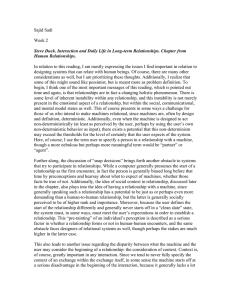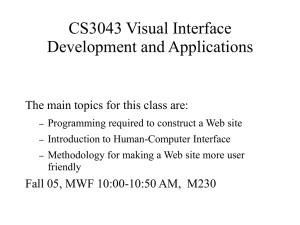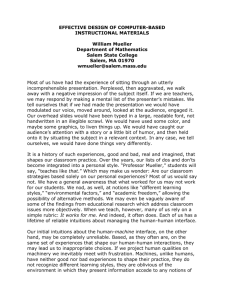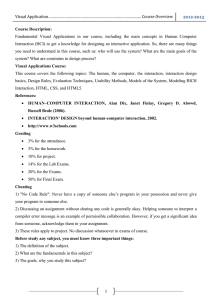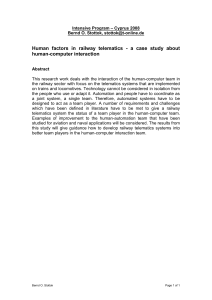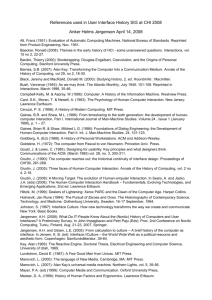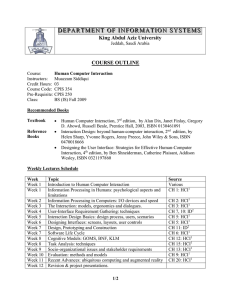Randy Rockinson Week 2 Ownership: Attachment Versus Psychological Support.
advertisement
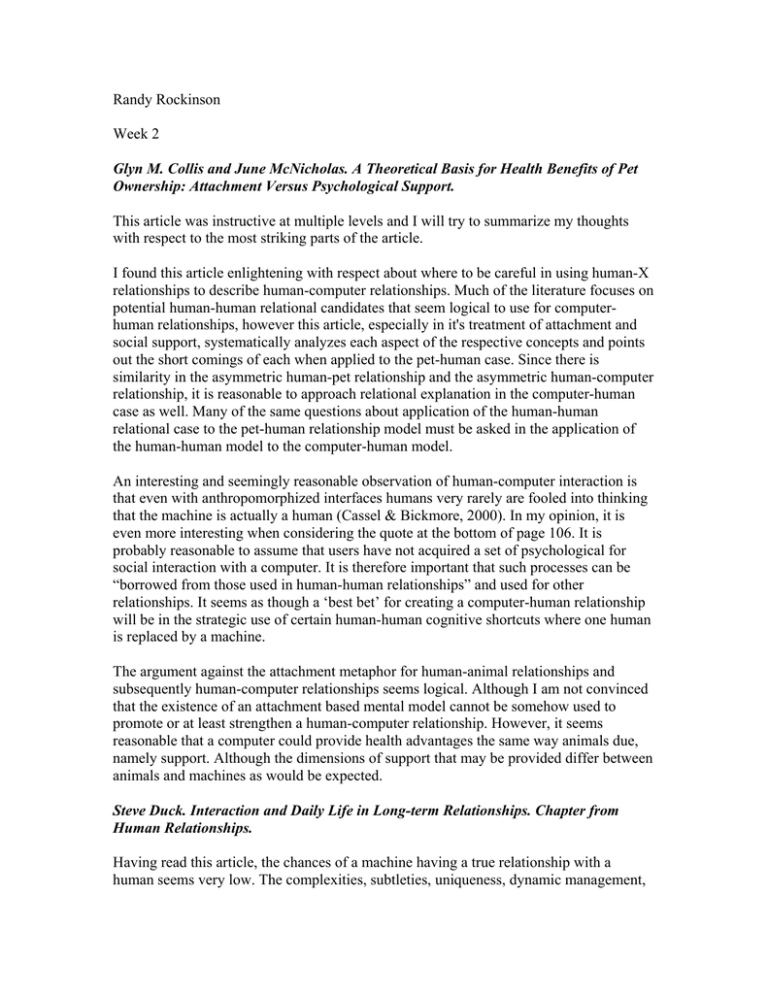
Randy Rockinson Week 2 Glyn M. Collis and June McNicholas. A Theoretical Basis for Health Benefits of Pet Ownership: Attachment Versus Psychological Support. This article was instructive at multiple levels and I will try to summarize my thoughts with respect to the most striking parts of the article. I found this article enlightening with respect about where to be careful in using human-X relationships to describe human-computer relationships. Much of the literature focuses on potential human-human relational candidates that seem logical to use for computerhuman relationships, however this article, especially in it's treatment of attachment and social support, systematically analyzes each aspect of the respective concepts and points out the short comings of each when applied to the pet-human case. Since there is similarity in the asymmetric human-pet relationship and the asymmetric human-computer relationship, it is reasonable to approach relational explanation in the computer-human case as well. Many of the same questions about application of the human-human relational case to the pet-human relationship model must be asked in the application of the human-human model to the computer-human model. An interesting and seemingly reasonable observation of human-computer interaction is that even with anthropomorphized interfaces humans very rarely are fooled into thinking that the machine is actually a human (Cassel & Bickmore, 2000). In my opinion, it is even more interesting when considering the quote at the bottom of page 106. It is probably reasonable to assume that users have not acquired a set of psychological for social interaction with a computer. It is therefore important that such processes can be “borrowed from those used in human-human relationships” and used for other relationships. It seems as though a ‘best bet’ for creating a computer-human relationship will be in the strategic use of certain human-human cognitive shortcuts where one human is replaced by a machine. The argument against the attachment metaphor for human-animal relationships and subsequently human-computer relationships seems logical. Although I am not convinced that the existence of an attachment based mental model cannot be somehow used to promote or at least strengthen a human-computer relationship. However, it seems reasonable that a computer could provide health advantages the same way animals due, namely support. Although the dimensions of support that may be provided differ between animals and machines as would be expected. Steve Duck. Interaction and Daily Life in Long-term Relationships. Chapter from Human Relationships. Having read this article, the chances of a machine having a true relationship with a human seems very low. The complexities, subtleties, uniqueness, dynamic management, and low success rate of human-human relationships seem to be foreboding for the less adaptive, more constrained machine. However, perhaps the model of human-computer relationships is less complex and demanding than that of human-human relationships. Encouraging aspects of relationships, especially for a relationship that purports to affect an intrinsic behavioral change, do seem to exist. 1. The fact that a relationship effects a persons self-esteem or ‘sense of being’ shows that if a machine can create a relationship that by virtue of that relationship a positive intrinsic change can happen if the relationship is properly managed. Note: A big ‘IF’ on either end of that statement. 2. The existence of overarching models. For example, Honycutt’s view of relational stages could provide a framework for human-machine relationship building. 3. Self-disclosure, a mechanism that is more easily facilitated by a machine, is a human device for giving and receiving advice. Providing a self-disclosure mechanism may provide opportunities for a machine to make behavioral suggestions and gain information relating to the users current behavioral state. 4. Similarity and reciprocation seem to be opportunistic in the forming of a humanmachine relationship. Duck states that dissimilarity can be overcome by interaction if the user may be enticed to interact with machine over time. In light of the above positive statements, the following questions come to mind: 1. An important feature of a relationship is the prolonged and perhaps difficult start of a relationship. In computer design the question of enticement come into play. That is, how does a computer create enough incentive for a person to spend the effort to start a relationship? Note: It is imperative that the first impression that the user has about the computer is favorable and that small ‘trivialities’, such as design, do not ‘derail’ things as is easily done in human-human relationships. 2. How should a machine effectively communicate it’s similarity to the user? 3. How does a machine understand subtle, nonverbal behavior? Perhaps through Affective computing? 4. How does a computer effectively use reciprocation? How does it tell the correct time to use reciprocation? Finally, since reciprocation seems to degrade in the long term, how does a machine keep it’s dynamic with a user over time without a complex and highly customized model of the user? I think the crux of the problem lies in the answer to these questions. Tim Bickmore. Theory. Not surprisingly from the title of this chapter, a good overview of theory was presented. I particularly enjoyed the discussion of the AI view of these theories and the use of FOL. Also, the systematic and precise definitions of relationships provide a nice base definition of relationships. However, as with most AI, and as I think Bickmore at least indirectly acknowledges, while precise these definitions are lacking some of the more ‘intangible’ aspects of human-human relations. In any case, this presentation has made me start to think about how to encapsulate the lessons learned in social psychology papers into machine useable representations. Second, this work began to deal with some of the questions I addressed in my summary of Duck’s paper. Of particular interest to me was the presentation of rights and obligations in an AI sense in order to encapsulate social structure in the understanding of the machine. This obviously will promote the avoidance of social blunders that will cause long-term use to never happen. Also, the discussion of the need for both affective and nonverbal communication aspects of human-machine relationships is, at least in my opinion, imperative for human-computer relationships that are equivalent to humanhuman relations. I am not sure they are necessary for all human-computer relational models however. What I particular like about his work is the explanation of interactional and relational conversational meaning. The use of small talk to build trust and, in turn, help facilitate the relational and social communication is neat in the fact that an interface does not have to be anthropomorphized in order to take advantage of such a social mechanism.
